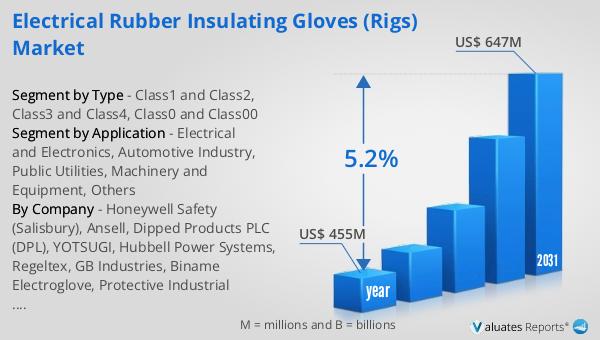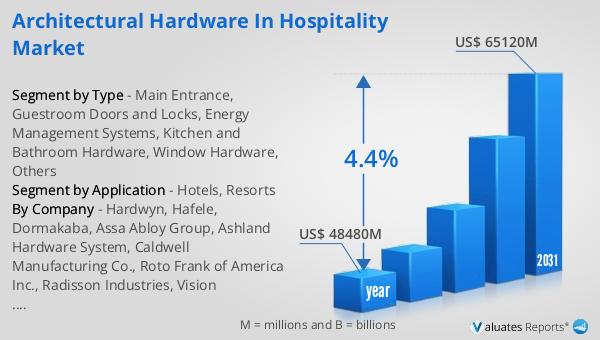What is Global Electrical Rubber Insulating Gloves (RIGs) Market?
The Global Electrical Rubber Insulating Gloves (RIGs) Market is a specialized segment within the personal protective equipment industry, focusing on gloves designed to protect workers from electrical hazards. These gloves are made from high-quality rubber materials that provide insulation against electric shocks, making them essential for individuals working in environments with high voltage risks. The market for these gloves is driven by the increasing demand for safety measures in industries such as electrical and electronics, automotive, and public utilities. As safety regulations become more stringent worldwide, the need for reliable protective gear like RIGs continues to grow. These gloves are categorized based on their voltage protection levels, ensuring that workers have the appropriate level of protection for their specific tasks. The market is characterized by continuous innovation, with manufacturers striving to improve the durability, comfort, and effectiveness of these gloves. As industries evolve and new technologies emerge, the demand for advanced protective equipment like electrical rubber insulating gloves is expected to rise, highlighting the importance of safety in the workplace. The global market for these gloves is not only about protection but also about ensuring compliance with safety standards, which is crucial for both worker safety and operational efficiency.

Class1 and Class2, Class3 and Class4, Class0 and Class00 in the Global Electrical Rubber Insulating Gloves (RIGs) Market:
In the Global Electrical Rubber Insulating Gloves (RIGs) Market, gloves are classified into different classes based on the level of voltage protection they offer. Class 1 and Class 2 gloves are designed for medium voltage applications. Class 1 gloves provide protection up to 7,500 volts, while Class 2 gloves offer protection up to 17,000 volts. These gloves are typically used by workers in industries where they might encounter medium voltage levels, such as in certain electrical maintenance tasks or in the automotive industry where hybrid and electric vehicles are involved. The gloves are designed to be flexible and comfortable, allowing workers to perform their tasks without hindrance while ensuring their safety from electrical shocks. Class 3 and Class 4 gloves are intended for high voltage applications. Class 3 gloves protect against voltages up to 26,500 volts, and Class 4 gloves offer protection up to 36,000 volts. These gloves are crucial for workers in high-risk environments, such as those working on power lines or in electrical substations. The gloves are made from thicker rubber to provide the necessary insulation, and they are often used in conjunction with other protective gear to ensure maximum safety. Class 0 and Class 00 gloves are designed for low voltage applications. Class 00 gloves provide protection up to 500 volts, and Class 0 gloves offer protection up to 1,000 volts. These gloves are commonly used in environments where workers are exposed to lower voltage levels, such as in electronics manufacturing or in routine electrical maintenance tasks. Despite their lower voltage rating, these gloves are essential for ensuring worker safety and preventing electrical accidents. Each class of gloves undergoes rigorous testing to ensure they meet safety standards and provide the necessary protection. The classification system helps industries select the appropriate gloves for their specific needs, ensuring that workers are adequately protected based on the voltage levels they are likely to encounter. This classification not only enhances safety but also helps in maintaining compliance with industry regulations, which is crucial for operational efficiency and worker protection.
Electrical and Electronics, Automotive Industry, Public Utilities, Machinery and Equipment, Others in the Global Electrical Rubber Insulating Gloves (RIGs) Market:
The usage of Global Electrical Rubber Insulating Gloves (RIGs) Market spans across various industries, each with its unique requirements and safety standards. In the Electrical and Electronics sector, these gloves are indispensable for technicians and engineers who work with electrical circuits and components. The gloves provide the necessary insulation to protect against accidental contact with live wires, ensuring the safety of workers as they perform installations, repairs, and maintenance. In the Automotive Industry, the rise of electric and hybrid vehicles has increased the demand for RIGs. Mechanics and engineers working on these vehicles require protection from the high voltage systems that power them. The gloves allow them to safely handle electrical components, ensuring both their safety and the integrity of the vehicle's systems. Public Utilities, such as power generation and distribution companies, rely heavily on RIGs to protect their workers. Linemen and technicians who maintain power lines and electrical infrastructure are often exposed to high voltage environments. The gloves are a critical component of their safety gear, providing the necessary protection to prevent electrical accidents. In the Machinery and Equipment sector, RIGs are used by workers who operate or maintain electrically powered machinery. The gloves protect against accidental contact with live electrical parts, ensuring the safety of workers as they perform their duties. Other industries, such as construction and manufacturing, also utilize RIGs to protect workers from electrical hazards. The gloves are used in various applications, from routine maintenance tasks to complex installations, highlighting their versatility and importance in ensuring workplace safety. The widespread use of RIGs across these industries underscores the critical role they play in protecting workers and maintaining compliance with safety regulations.
Global Electrical Rubber Insulating Gloves (RIGs) Market Outlook:
The global market for Electrical Rubber Insulating Gloves (RIGs) was valued at $455 million in 2024, with projections indicating a growth to $647 million by 2031. This growth represents a compound annual growth rate (CAGR) of 5.2% over the forecast period. The increasing demand for safety measures in various industries is a key driver of this market expansion. As industries continue to prioritize worker safety and compliance with stringent safety regulations, the demand for reliable protective gear like RIGs is expected to rise. The market's growth is also fueled by advancements in glove technology, with manufacturers focusing on enhancing the durability, comfort, and effectiveness of these gloves. The projected growth of the RIGs market highlights the importance of safety in the workplace and the ongoing need for protective equipment that meets industry standards. As industries evolve and new technologies emerge, the demand for advanced protective equipment like electrical rubber insulating gloves is expected to rise, highlighting the importance of safety in the workplace. The global market for these gloves is not only about protection but also about ensuring compliance with safety standards, which is crucial for both worker safety and operational efficiency. The market's growth trajectory underscores the critical role that RIGs play in protecting workers and maintaining compliance with safety regulations.
| Report Metric | Details |
| Report Name | Electrical Rubber Insulating Gloves (RIGs) Market |
| Accounted market size in year | US$ 455 million |
| Forecasted market size in 2031 | US$ 647 million |
| CAGR | 5.2% |
| Base Year | year |
| Forecasted years | 2025 - 2031 |
| Segment by Type |
|
| Segment by Application |
|
| Consumption by Region |
|
| By Company | Honeywell Safety (Salisbury), Ansell, Dipped Products PLC (DPL), YOTSUGI, Hubbell Power Systems, Regeltex, GB Industries, Biname Electroglove, Protective Industrial Products (PIP), Derancourt, Saf-T-Gard, Stanco Manufacturing, CATU, Secura B.C., Shuangan, Maxisafe, Boddingtons Electrical, Orion, Cementex Products, Inc. |
| Forecast units | USD million in value |
| Report coverage | Revenue and volume forecast, company share, competitive landscape, growth factors and trends |
